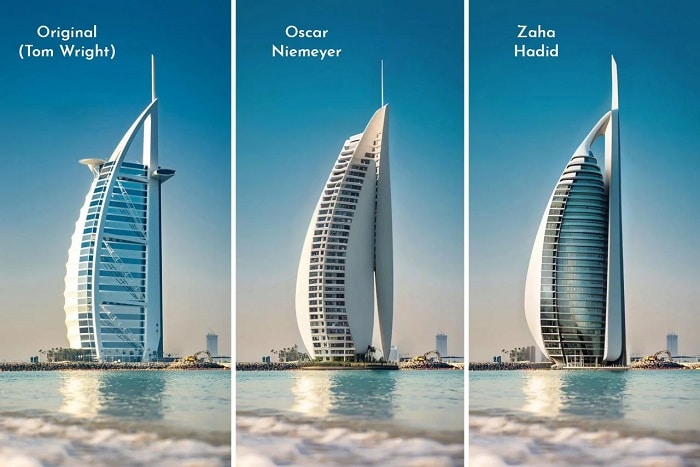
Dubai’s Burj Al Arab stands at an imposing 321 meters—a landmark comparable to the Empire State Building. Designed by Tom Wright of WS Atkins and completed in 1999, this seven-star hotel boasts the world’s tallest atrium, occupying more than half its height. Imagined Architecture has assembled a captivating collection, reenvisioning the iconic hotel through the creative lenses of 10 legendary architects.
Image Credits: Imagined Architecture
Frank Gehry: Infused with Gehry’s avant-garde touch, the building maintains its sail-like silhouette while incorporating undulating shapes, controlled chaos, and asymmetric windows, creating a whimsical yet sophisticated design.

Zaha Hadid: In Hadid’s reinterpretation, the sail-like structure transforms into a sinuous form, emphasizing fluidity, transparency, and a futuristic aesthetic. The blend of glass and white elements pays homage to her iconic use of stark contrasts and reflective surfaces.

Le Corbusier: Drawing inspiration from Le Corbusier’s modernist principles, the sail shape remains, but the stark white facade reflects his minimalist approach, blending luxury with functional simplicity.

Oscar Niemeyer: Inspired by Niemeyer’s love for curves, the building takes on a graceful wave-like form, utilizing crisp white tones to stand out against the blue sky. The design captures the essence of nature, creating a smooth and organic appearance.

Walter Gropius: Gropius simplifies the silhouette, featuring clean lines and unadorned glass panels, blending luxury with the Bauhaus ideals of simplicity and practical beauty.

Frank Lloyd Wright: Integrating the Burj Al Arab with its environment, Wright adds horizontal lines, terraces, and a gentle curvature, creating a serene yet grandiose dwelling place in harmony with the vast seascape.

Antoni Gaudi: Gaudi’s playful twist incorporates whimsical curves, intricate patterns, and a modern touch with a white exterior, transforming the Burj Al Arab into a functional work of art inspired by nature.

Tadao Ando: Reflecting Ando’s minimalist approach, the design strips away ornateness, revealing clean surfaces and a stark white facade, emphasizing geometric clarity and a thoughtful integration with the environment.

Bjarke Ingels: Ingels introduces mild undulations, large glass windows, and a sleek white exterior, striking a balance between luxury and innovation, creating an inviting and sustainable architectural landmark.

Jeanne Gang: Gang’s design seamlessly integrates with the seascape, emphasizing transparency, organic forms, and a commitment to harmonizing with nature, introducing a fluidity and grace to the iconic silhouette.

